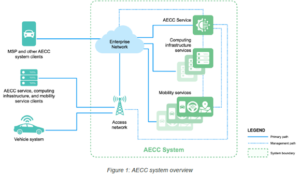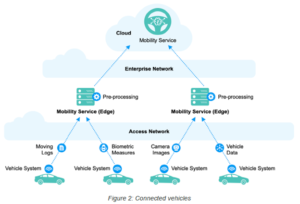Use of Distributed Computing for Mobility Services in an AECC System

The Automotive Edge Computing Consortium (AECC) has produced a new whitepaper titled Distributed Computing in an AECC System v1.0.0. It explores requirements for the distributed off-vehicle computing environment to support mobility services for hundreds of millions of future connected vehicles. In this Q&A, AECC President and Chairperson Ken-ichi Murata, Technical Solutions WG Chair Leifeng Ruan, and Technical Solutions WG Distributed Computing SIG Leader George Ericson describe how OEMs, MNOs, cloud providers and other stakeholders in the connected vehicle ecosystem can benefit from the whitepaper.
Q1: What is this whitepaper about?
Distributed Computing in an AECC System v1.0.0 provides an overview of distributed computing applied in the connected vehicle industry. The document illustrates service and architecture level requirements as well as a functional architecture for distributed computing in the context of automotive edge computing. It also provides an initial solution profiling to analyze existing technologies from other standards organizations and open-source communities to identify candidate solutions to satisfy AECC requirements and capture potential gaps to be addressed by connected vehicle stakeholders.
Q2: How does distributed computing fit within the AECC ecosystem?
The AECC ecosystem is a collection of AECC systems – each composed of an AECC service, computing infrastructure services, mobility services and the access networks, and gateway networks that provide access to vehicles and to clients of the AECC and mobility services. The whitepaper focuses on the distributed computing element because a mobility service may be both decentralized and distributed between center and edge locations (see Figure 1).

Q3: Why is distributed computing important for connected vehicle use cases?
There are two important differences in connectivity and distributed computing for connected vehicles. First, data transfer for standard consumer mobility services flows mostly one way, as downloads from the provider to the consumer. For connected vehicles, the primary direction of data transfer is uploads from the vehicle to the provider. For connected vehicles, the amount of uploaded data is massive, concentrated (in time and location) and often time sensitive. The AECC estimates that connected vehicles will transfer up to 10 exabytes of data per month in 2025 (see the AECC General Principle and Vision white paper).
Second, to provide desired service levels, the mobility service may need to use different mobility service instances such as ones that are close to the vehicle – hence the need for distributed computing capability in an AECC system.
As shown in Figure 2, a mobility service may be both decentralized and distributed between center and edge locations. Edge components of a mobility service play important roles. One is to provide faster responses to requests from vehicles. Another is to offload the cloud and transport networks. A provider may also have to comply with regulation requirements; for instance, some types of data might not be allowed to cross country borders.
With an AECC system enabling service at the edge, application owners or mobility service providers can define data reduction contexts. For example, when multiple images are uploaded by different vehicles for the same road segments, the service at the edge can preprocess these images and propagate a reduced, curated subset of the uploads. The service at the edge also allows applications to set global quotas for a given regional area. Such quotas might govern the number or size of uploads in a specified timeframe. We expect access network bandwidth to increase significantly with the progression to 5G. Smart management of uploads can “flatten the curve” of usage of the access network and avoid spikes of duplicate data from a busy street and peak hours.

Q4: What are requirements for distributed computing in an AECC system?
For the full answer, you’ll need to read the whitepaper! But in a nutshell, there are two areas of requirements: service and architecture. An AECC system supports two types of services. The first are mobility services, such as intelligent driving and high-definition mapping. The second are AECC services that present a common management interface for the constituent computing infrastructure, enabling the orchestration of resources and services necessary to support the deployment of distributed mobility services at scale. Architectural requirements enable computing platforms that may take different forms and may have different proximities to connected vehicles. Architectural requirements specified in the whitepaper address access networks, computing platforms, mobility services, distributed data routing, and elements of a functional architecture.
Q5: How do existing distributed computing solutions fit within an AECC system?
Many existing distributed computing solutions address some AECC service and architectural requirements described in Distributed Computing in an AECC System v1.0.0. The whitepaper initially profiles the solutions developed by the following organizations:
- 3rd Generation Partnership Project (3GPP)
- 5G Automotive Association (5GAA)
- Network Function Virtualization (NFV) by European Telecommunications Standards Institute (ETSI) Industry Specification Group (ISG) NFV
- Multi-access Edge Computing (MEC) by ETSI ISG
- Internet Engineering Task Force (IETF) Locator/ID Separation Protocol (LISP)
- Linux Foundation (LF) Edge
- Intel® Smart Edge Open (formerly OpenNESS)
For automotive use cases, each of these solutions works on different layers of the AECC architecture. The IETF and 3GPP provide underlying infrastructure specifications. The ETSI NFV and MEC provides an abstraction of the overall architecture and specifies application programming interfaces (APIs). LF Edge provides deployment blueprints that may leverage technologies, such as the way it is implemented in Intel® Smart Edge Open. Meanwhile, consortia such as the 5GAA and the AECC are focusing on how to leverage existing standards and technology in a business scenario. The whitepaper provides a detailed gap analysis of all these solutions in the context of an AECC system.
Q6: What’s next for AECC’s vision of distributed computing for connected vehicles?
Distributed Computing in an AECC System v1.0.0 provides an initial framework for implementing distributed computing for the automotive industry. It illustrates service and architecture level requirements as well as a functional architecture for distributed computing in the context of automotive edge computing. It also provides an initial solution profiling to analyze existing technologies from other standards organizations and open-source communities to identify candidate solutions to satisfy AECC requirements and capture potential gaps.
The work is still underway to further detail AECC requirements and solution profiling that can enable this AECC distributed computing functional architecture. The AECC will also continue to fine tune the distributed computing functional architecture and enhance the technical solutions to fix any gaps and fulfil AECC architectural and functional requirements in conjunction with the other organizations’ existing solutions.
Q7: How can companies get involved with the AECC?
We encourage OEMs, MNOs, technology companies and cloud providers to consider the whitepaper’s findings for conceptualizing and implementing new mobility services. The AECC thrives on a diversity of perspectives and ideas. We invite companies to join the AECC to shape how connected vehicle innovations can come to life. The AECC’s working groups are scrutinizing the technology choices available and what new functionality will be needed. Companies participating in the AECC have full access to these discussions and how the organization forms the technology and business recommendations for the next generation of connectivity and networks. Members also may engage in various membership initiatives, technical working groups and member-only meetings. We invite technology and solutions providers to join the consortium’s efforts to ensure that new technologies and standards will meet the future needs of the full connected car value chain.
Learn more about the AECC’s Vision for Connected Vehicles
If you’d like to learn more details about our work and preliminary recommendations for addressing the challenges described above, we invite you to read the full whitepaper, Distributed Computing in an AECC System v1.0.0. For additional background, we invite you to read our General Principle and Vision white paper and our technical report, Driving Data to the Edge: The Challenge of Traffic Distribution.
Meanwhile, keep your eye on this blog for new insights, and follow us on Twitter and LinkedIn for all the latest.
